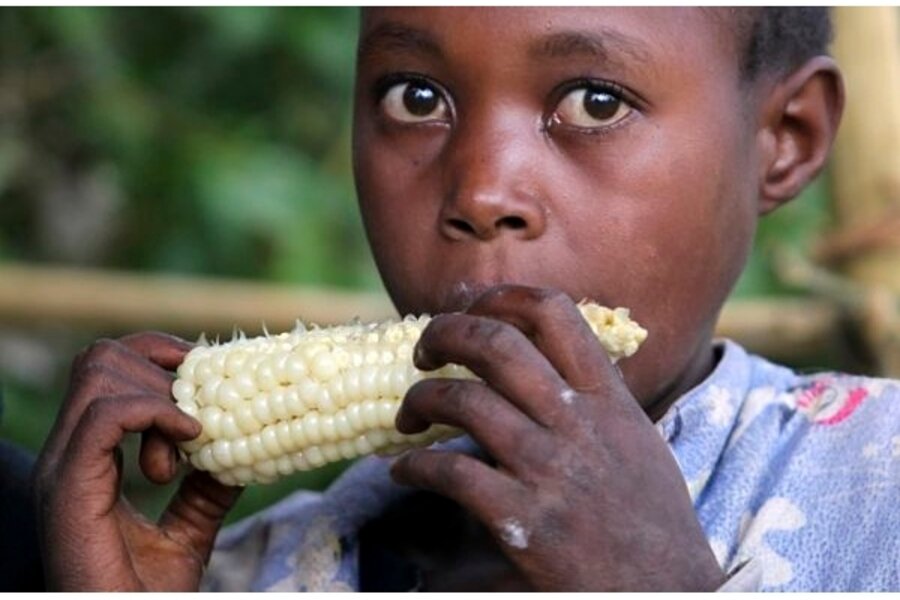Plant scientists build a 'Sears catalog' for corn genome
Loading...
Plant scientists announced last week they have built the foundation for a complete catalog for corn genes, with far-reaching implications for humanity's food supply.
Researchers have been working on the genome-sequencing project for four years. The draft sequence, now 95 percent complete, has given scientists a point of comparison they can use to begin measuring the range of genetic diversity among different varieties of corn, or maize.
The diversity is represented in what researchers call a haplotype map, or hapmap. Such maps are expected to help scientists zero in on specific genes or groups of genes that give the plants important traits.
Armed with more-precise genetic information, researchers say, breeders could develop new maize varieties that withstand prolonged heat and drought, use nutrients such a nitrogen more efficiently, or pack more nutrition per kernel. They could do it in far less time than it currently takes to develop new varieties.
The results represent "an enormous advance for science and for agriculture on the planet and all those who depend upon it," says Molly Jahn, a former plant geneticist and now US deputy undersecretary of agriculture for research, education, and economics. The USDA helped fund the project.
For milleniums, breeders have had labored long and hard to improve crops, based on effects they observed in the fields. In essence, they were a bit like architects admiring a building from the outside and then trying to replicate it without a blueprint to follow.
The genome is akin to having the blueprints for the building "from basement to attic," Dr. Jahn says.
The genome sequence for corn, plus the first haplotype map comparing the newest sequence with genes from 27 other varieties, appeared this week in the journal Science. Another set of papers looking at the biological implications of the genome were published this week in the on-line journal Public Library of Science Genetics.
Hints of the potential power of this information comes from rice. Scientists finished virtually complete gene sequences for two varieties of rise in 2002. Four years later, researchers announced they'd found two genes responsible for allowing rice to survive inundation for long periods of time. Last year, a team of Japanese scientists found similar genes in another variety of rice. Flood-tolerance rice is now undergoing field trials in Bangladesh. You can read more about it here, here, and here.
For the USDA's Jahn, one of the key goals for corn is to improve its efficiency in taking up nitrogen as a nutrient. This would allow farmers to deliver less fertilizer to their corn fields, reducing fertilizer run-off that pollutes streams, rivers, and contributes to aquatic "dead zones" where rivers such as the Mississippi meet the ocean.
The power of the gene sequence really comes into play once sequences are available for several different varieties, says Gary Atlin, a maize specialist at the International Maize and Wheat Improvement Center near Mexico City.
Getting there will be a long, complicated process, he acknowledges -- although some of the hardware needed to do the job is getting faster and cheaper.
"The cost of sequencing a plant is dropping extremely rapidly," Jahn says. These days, it costs roughly $10,000 to process a plant's genetic material. By 2013, some experts expect the job to cost $100, and take abut 15 minutes, she says.
The corn genome published this week is complex -- some 32,000 genes corralled into 10 chromosomes, compared with 20,000 genes spread among 23 chromosomes for humans. Each gene is a unique combination of four compounds, or nucleotides, that make up the genome's "alphabet."
The real power of having a full genome in hand comes when sequences are available for several corn varieties, Dr. Atlin adds.
"Having the detailed information on differences at the single-nucleotide level between lines in a breeding program is the key to being able to accelerate breeding progress for traits like drought tolerance or heat tolerance," he says -- traits that are increasingly important in food-growing regions confronted with a warming climate.
Editor’s note: For more articles about the environment, see the Monitor’s main environment page, which offers information on many environment topics. Also, check out our Bright Green blog archive and our RSS feed.





